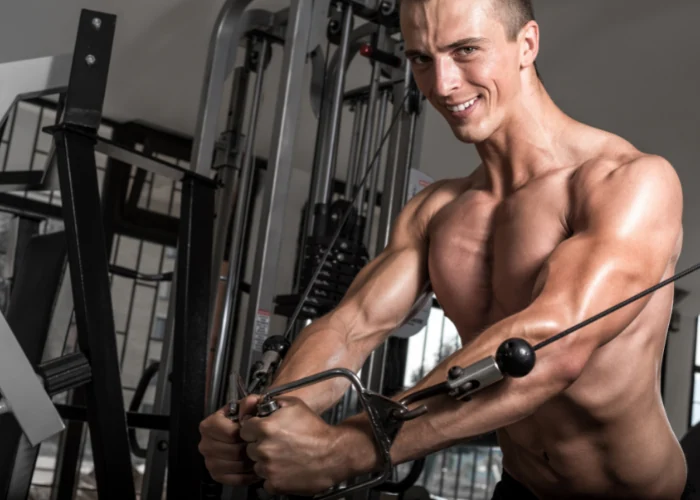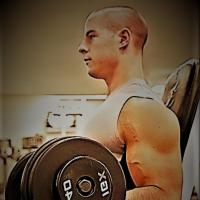There's no denying that a cable crossover machine is an effective piece of equipment. You can do dozens of exercises with it and get almost a full-body workout.
But what if you don't have access to a gym and can't afford to furnish your home gym with one?
Enter the cable crossover alternatives! The moves we're going to talk about use everything from bodyweight to free weights, so there's something for everyone.
Can I Really Get Ripped Without a Cable Crossover Machine?

"Look at me, I'm using a cable crossover machine"... Ohhhh
Yes, of course, you can. Do you think every single person you see on the street with muscles has a cable machine in their house or can afford a gym membership?
Especially in the days of the pandemic, access to a standard cable machine can be very limited. But even after the pandemic is "over" you may not have access to a machine designed specifically for cable crossovers.
As long as you know how to do chest exercises with intelligence and focus, you can work your pectoral muscles to the max without a machine.
TL;DR: Yes, you can get ripped without a cable crossover machine. Bookmark this article for your go-to cable crossover alternative moves.
What Muscles Do Cable Crossovers Work?

Cable crossovers work your chest muscles in a specific way. So it's not only about working your pecs but about using the full range of your chest's motion.
Think about sitting at a pec deck machine (another name for a cable machine). You sit with your back against a bench support and grasp the handles of the machine.
Usually, the starting position of these handles is slightly behind your body. That reach, or stretch, is pushing to the end-range of your chest muscles. That means your chest is doing almost all the work when you pull the handles forward doing machine exercises.
The most effective cable crossover alternatives will work similarly: pushing to the end-range of your chest muscles, including:
- Pectoralis major and minor (upper and lower pectoral muscles)
- Deltoids
- Shoulders/shoulder blades
- Upper back muscles
TL;DR: Cable crossover machines work most of your chest muscles and other muscles in your upper body.
Our 13 Best Cable Crossover Alternatives
The following alternative exercises will get you the same benefits of a cable crossover machine.
1. Resistance Band Crossover
Resistance bands are a stellar way to up your home gym workouts with little space and expense. In addition, these bands often come in various strength levels so you can make progress in your chest workout.
The resistance band crossover is like doing a standard dumbbell fly but standing up. So it's perfect for targeting the muscles in the middle of your chest.
How-To:
- Secure your resistance band around a steady pole or post. Or, secure it in a door anchor at about hip height.
- Grip a handle in each hand and step forward, away from the anchor point, until your arms are just behind your torso. You should feel a gentle stretch across your chest.
- With a slight bend in your arms, keep your back straight and your head and chest up. Your arms should be parallel to the floor.
- Inhale, then exhale and pull the handles forward, keeping your elbows slightly bent. Extend your arms out and cross one handle over the other. Alternate which arm crosses over in each rep.
- With control, slowly release the handles back until you feel that gentle stretch across your chest again.
2. Incline Dumbbell Fly
An incline dumbbell fly is also called an incline chest fly. You're doing a chest fly with dumbbells on an incline bench. (If you don't have it already, get yourself a solid incline dumbbell setup for your home gym.)
A dumbbell fly has similar benefits to the crossover in that it stretches your muscles past what you'd get if you were lying on the ground. This gives you a greater range of motion, meaning more muscle engagement and making it an excellent cable crossover alternative.
How To:
- Adjust the bench to about a 30 or 45-degree incline. Sit down with both feet on the floor. Lie back and raise the dumbbells over your chest, keeping your elbows slightly bent and palms facing each other.
- Inhale as you slowly lower the bells, keeping that slight bend in your elbows until you feel the stretch in your chest.
- Exhale as you bring the bells back to the starting position, always maintaining the arc.
3. Chest Dips
Chest dips are one of our favorite cable crossover alternatives. They're a compound, bodyweight exercise that hits so many major muscle groups in one go, it's ridiculous.
The key to making this exercise focus on your chest is to lean forward during the move.
How To:
- Position yourself between two sturdy parallel bars. Grip each bar firmly and lift yourself up so you're holding your body weight at arm's length. Make sure your arms are parallel with your torso and your head is in a neutral zone (don't look up or down). Keep your knees bent.
- Angle your torso slightly forward as you inhale and lower yourself between the bars until your shoulders are slightly below your elbows. Flare your elbows a bit, so you feel a stretch in your chest muscles.
- Exhale as you lift yourself back up. Keep leaning forward.
- Avoid locking your elbows when you reach the top.
If you don't have access to a dip bar, check out our best alternatives to chest dips.
4. Diamond Push-Ups
Get ready to take your push-up game to the next level. Diamond push-ups are the same as regular ones, except you have your hands close together in a diamond shape. (Your fingers will actually make what I think looks more like a triangle, but no one asked me to name the exercise.)
Note: if you still can't do regular push-ups, don't try these yet. They focus even more on your chest and triceps, so keep doing those regular ones first if you still need to build strength.
How To:
- Get on your hands and knees. Instead of placing your hands slightly wider than shoulder-width, bring them together with your pointer fingers and thumbs touching in the diamond shape. (Make sure your hands are directly under your chest, not too far forward.)
- Extend your legs back into a plank position. Keep your entire body tight and your head and spine neutral (in a straight line).
- Breathe in as you lower yourself toward the floor. Keep your elbows slightly tucked so they don't flare.
- Breathe out as you push back up. Make sure your entire body, especially your core muscles and legs, stay tight and engaged throughout the movement.
5. Dumbbell Squeeze Press
If you haven't heard of this, get ready to add it to your cable crossover alternatives STAT. This flat bench dumbbell exercise targets your pectoralis major (upper pectoral muscles). It also hits your deltoids and triceps, making an efficient upper body exercise.
The movement is similar to a bench press, except your focus is on squeezing the two dumbbells together as hard as you can. That's the key to activating your chest.
How To:
- Set up as you would for a flat dumbbell bench press (lie down on a bench, kick the weights up, etc.). Hold the weights above your chest, palms facing toward each other, pressing the dumbbells together.
- Retract your shoulder blades to create a slight arch in your spine. Inhale as you lower the dumbbells toward your chest.
- Exhale as you press the bells back up. Maintain the squeezing pressure throughout the entire movement.
6. Flat Bench Dumbbell Fly
This entry is a bit shorter, because we already covered the incline dumbbell fly. Now, an incline dumbbell fly engages mainly your upper pecs. However, when you use a flat bench, it also works your lower pectoral muscles. Both are essential in your chest workout.
How To:
If you want the step-by-step, revisit the incline version but lower your bench. Boom.
7. Dumbbell Pullover
Without access to a cable crossover machine, you can still target your chest with a dumbbell pullover.
"But wait," I hear you say, "I thought pullovers were for your lat muscles on your back?"
Yes, they can be. The key to focusing the movement on your chest is your elbows. If you keep them pulled in, you target your chest more than your back.
How To:
- Lay down on a flat bench. Place your feet on the floor, holding a dumbbell between your interlocked hands and above your chest. Keep your palms facing each other with elbows bent slightly and tucked inward.
- Inhale as you lower the weight over your head. Take 3–4 seconds to drop to wherever you feel the stretch in your chest.
- Exhale and flex your chest to bring the weight back to starting position.
Bad shoulder joints? Check our dumbbell pullover alternatives.
8. Wide Push-Ups
This is another chest exercise to implement if you've already mastered regular push-ups. Extending your arms wider than shoulder-width targets your chest and shoulders more than regular push-ups.
(AFor an extra challenge, try banded wide push-ups. Wrap a resistance band under each hand and across your upper back so as you lift up, you get added resistance.)
Your step-by-step is the same as diamond push-ups, except your hands are wider than your shoulders instead of in the diamond shape.
9. Single Arm Dumbbell Bench Press
A bench press is a staple of chest exercises. But doing a single-arm dumbbell bench press on a flat exercise bench really ups the ante (even without a cable crossover machine).
Why? Because now you're adding an element of balance to the equation. You have to recruit more core muscles — including your chest — to keep your body steady while you lower a single dumbbell.
Note: if you're already doing regular bench presses, start significantly lighter for a single-arm version. Your balance will be off at first, and you don't want to risk injury by trying to lift heavy.
How To:
- Lay back on a flat bench, holding a dumbbell in one hand. Maintain a slight arch in your low back and keep your feet flat on the floor.
- With your elbow bent and your arm perpendicular to your chest, exhale as you press the weight up. Make sure your core is braced, and you're not falling toward the side that's working.
- Inhale as you lower the weight back down. Don't lower the dumbbell past your chest (keep about a 90º angle).
10. TRX Chest Fly
TRX bands are your secret weapon when it comes to building strength with just your body weight. These bands attach to a secure point, and most exercises have you leaning away from that point to create the resistance. (Don't get me wrong, resistance bands are an excellent tool, but TRX bands are great to have in your lineup, too.)
Using TRX bands means your stability is severely compromised. Think about it: doing a fly on a bench, you've got your entire back supported and your feet flat on the ground.
Using TRX bands, on the other hand, means the only points of contact you have are your two feet (close together) and your two hands gripping the handles.
That means you need to recruit more fine motor muscles (like the ones in your wrists, ankles, hands, and core) to keep you stable.
How To:
- Start with the TRX bands in a high position. Stand between the bands and adjust the handles so they're even in front of you.
- Depending on your strength, either begin standing almost vertically, take enough steps back so that you're more horizontal, or take a single step back for medium work.
- Keep your glutes, hamstrings, and core tight and engaged. Make sure your spine is in a straight line. Your hands should be in front of your shoulders.
- Tense your pectoral muscles. Inhale as you lean forward, opening your arms to a T-position, keeping a slight bend in your elbows.
- Exhale as you squeeze your chest to bring your hands back in line with your shoulders.
11. Single Arm Band Fly
Resistance bands are back again! (Seriously, if you don't have a resistance band in your home gym, it's not only great for cable crossover moves, but it's an affordable way to build strength.)
A one-arm band fly is basically like doing a flat bench fly, except without a bench or dumbbells.
Once again, using one arm provides an extra challenge to your core. Your chest day won't be the same after this move.
How To:
- Secure your resistance band to a door at mid-height (about chest level). Make sure it's secure!
- Grip the handle with one hand and step away from the door (about 3 or 4 feet). Your arm should be pointing toward the door with a gentle bend in your elbow.
- Keep your palm facing forward, your back straight, your head neutral, and your feet shoulder-width apart.
- Exhale, brace your core, and flex your chest as you bring the handle around until your arm is in front of your chest. Keep your shoulders square so your upper body doesn't rotate.
- Inhale as you slowly release the handle back out.
12. Resistance Band Row
One of the best cable crossover alternative exercises is a resistance band row. This is a versatile exercise because you can progress by using heavier resistance bands. Plus, you can do this move in two different ways: seated or bent over.
If you're seated, you can hook your resistance band to anything sturdy (low door anchor, pillar, etc.). If you're bent over, hook it under your feet.
"But wait," I hear you saying again. "I thought rows were back exercises. How are they a replacement for cable crossovers?"
I'll tell you — they're not, exactly. But any experienced lifter knows you need a balance of body exercises. If you're exclusively training your chest (using a cable crossover or not), your posture will be affected (think rounded shoulders).
So, grab your resistance bands and a secure anchor point.
How To:
- Choose your appropriate strength resistance band and hook it underneath your feet. Hinge at your hips and keep your spine completely neutral. Grip the ends of the band in each hand.
- Keep your core tight. Exhale as you pull the ends of the band toward your chest, shoulder blades squeezing, keeping your elbows close to your body.
- Inhale as you slowly release the band back down.
13. Seated Dumbbell Raise
Rounding out our list of alternative exercises for cable crossovers is the seated dumbbell raise. This exercise mostly targets your deltoids (the front of your shoulder), but that muscle directly connects to your pecs, so you're still getting some solid chest work.
How To:
- Sit on a bench or stable surface. Hold a light pair of dumbbells at your sides, palms facing in.
- Keep your core tight and back nice and tall. Exhale as you lift the dumbbells straight out in front of you. Stop at about shoulder height.
- Inhale as you slowly lower the dumbbells back down to your sides.
Cable Crossover Alternatives
That's it.
You don't need a cable machine to build the strength and shape of your chest, shoulders, and upper back.
No more excuses. Just grab your resistance bands, some dumbbells, or your body weight, this list of cable crossover alternatives, and get to working.

